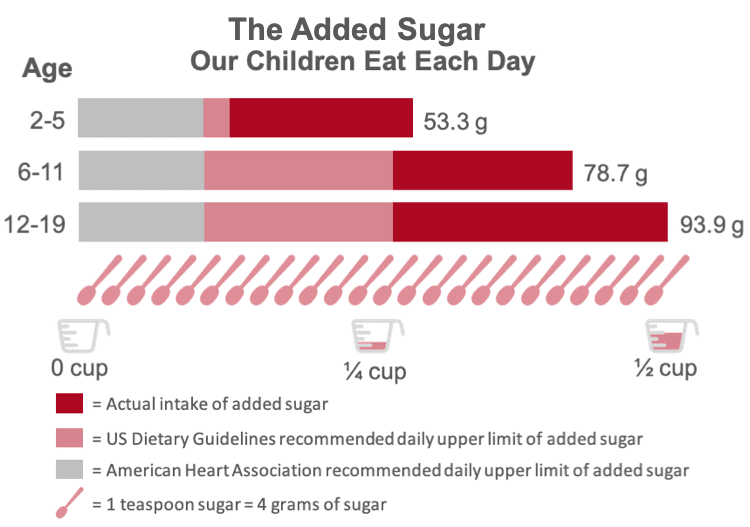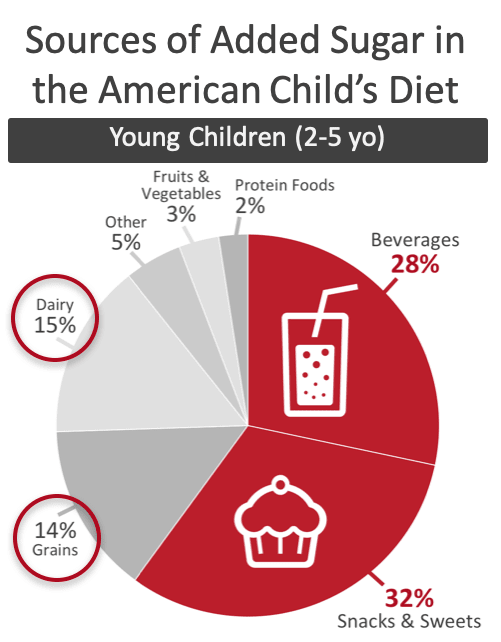Chances are if you or your child have a favorite food, added sugar is high on the ingredient list. Our palates are programed to crave sweetness, and food manufacturers have been exploiting this sweet preference for decades in an effort to get us to purchase and consume more of their products. However, the added sugar we love is making us sick.
How much added sugar do Americans eat each day?
The United States Department of Agriculture (USDA) estimated that in 2015, every American consumed more than 75 pounds of added sugar, which is about half a cup, 22 teaspoons, or 94 grams a day.(1)
That is almost 2 to 4 times the daily recommended amount, depending on who is making the recommendation!
Did you know that the FDA, AHA and WHO disagree on the maximum amount of added sugar we should eat each day? To learn more, check out this post on the Recommended Daily Intake of Added Sugar.
Both adults and children consume too much added sugar.
By the time children are 12, they are consuming the same amount of added sugar as an adult. Below is a chart of added sugar consumption by age in the US.

What foods have added sugar?
Added sugar is a key ingredient in most processed foods. You may be surprised to find it in salad dressing, pasta sauce, crackers and other savory foods. In fact, almost 25% of our daily added sugar intake comes from savory foods.
The following chart details the many sources of added sugars in the American diet.(2)

Almost half of our daily intake of added sugar comes from sweetened beverages (soda, fruit drinks, coffee drinks, sports and energy drinks).
However, sugary drinks and treats are not the only sources of added sugars in our diet. Many foods considered “healthy” also contain added sugar.
In fact, almost 30% of the added sugar young children eat is from the dairy and grains they eat!

Dairy (15%) and grains (14%) account for a sizable amount of young children’s daily intake of added sugar. If you find that surprising, just read the label of a flavored yogurt or cereal (more on flavored yogurt and cereal soon).
Why is it important to limit added sugar?
Added Sugars are Empty Calories
There is no health benefit to eating added sugar.
Numerous experts and government agencies, including the American Heart Association, agree that it is very challenging, if not impossible, to meet our daily nutrient requirements while while consuming added sugars at our current level.(2, 4, 5)
The sugary foods we eat either displace the nutrient dense foods we should be eating or are eating in addition to our regular meals, which leads to obesity.
Too Much Added Sugar is Making Us Fat
There is a strong linkage between eating too much added sugar and weight gain.
A randomized, controlled clinical trial evaluated how sugar sweetened beverages affect the weight of school children. After 18 months, a slower rate of weight gain and less fat accumulation was measured in the group drinking the noncaloric beverages.(6)
Too Much Added Sugar Can Increase Triglyceride Levels
Consuming too much added sugar is correlated with increased triglyceride levels. High levels of triglycerides, a lipid (fat) in your blood, can increase your risk of coronary heart disease.
Numerous clinical studies have found that eating fructose from added sugar can increase triglyceride levels. And in studies where patients reduced their fructose intake, a corresponding reduction in triglycerides was experienced.(2, 7)
How does added sugar increase triglyceride levels? Common added sugars, such as table sugar and high fructose corn syrup, contain approximately equal amounts of glucose and fructose. Though glucose can be used by almost every cell in the body for fuel, fructose is metabolized almost exclusively in the liver.
When too much fructose is consumed at one time, the liver is overwhelmed and creates new lipids (fat molecules) with excess fructose. These lipids can accumulate in the liver or be released into the blood, resulting in increased triglyceride levels.
Excess Added Sugar Raises Blood Pressure
Epidemiological and clinical trial data suggest that excessive fructose consumption, from eating too much added sugar, increases blood pressure in children, young adults, and adults.(2, 8)
The opposite also appears to be true. In a small-scale clinical trial, 28 people were placed on a very low fructose diet and after 6 weeks saw an average decrease of 6 mmHg in both systolic and diastolic blood pressures.(9)
Added Sugar Contributes to Chronic Inflammation
Researchers from Harvard University analyzed data from several large-scale clinical studies to rank foods by their ability to cause chronic inflammation.(10) Sugar sweetened beverages and refined grains are consistently linked to chronic inflammation.
Check out this post to learn more about which foods contribute to chronic inflammation and what foods are anti-inflammatory?
Eating Too Much Added Sugar Reduces Overall Diet Quality
Though the exact cause is unclear, eating too much added sugar is believed to reduce overall diet quality.
A recent study examined how the beverage at a meal effects the overall amount of vegetables young children eat.(11) The researchers found that consuming even small amounts of a sweetened beverage led children to eat fewer vegetables. Conversely, when given water to drink, the children ate a larger portion of vegetables.
The researchers hypothesize that the sweetness of the beverage clashed with the less-sweet and sometimes bitter flavor profile of the vegetables, reducing their likability.
Eating too much added sugar does not just impact vegetable consumption. In a 9-year study of Finnish children, researchers found that long-term excessive added sugar intake replaced dairy products, grain and other micronutrient-dense foods in the children’s diet.(12)
It is unclear whether these less healthy food choices are the result of excess sweetness on the palate or learned eating behaviors. However, it is important to realize that eating too much added sugar likely reduces the overall nutritional quality of our diet.
Final thoughts on added sugar
One of the simplest ways to potentially improve our long-term health is to reduce the amount of added sugar we eat in our daily diet.
The first step is to realize just how much added sugar we are in fact eating. If your added sugar consumption is high (most of ours is), start reducing it.
Limit sugary beverages and treats or cut them out all together, except on special occasions. Set a daily added sugar budget and try to stick with it. Try to make healthy food choices and help your children do the same.
Did you know that the FDA, AHA and WHO disagree on the maximum amount of added sugar we should eat each day? To learn more, check out this post on the Recommended Daily Intake of Added Sugar.
References:
- USDA, ERS (Economic Research Service), Sugar and Sweeteners Outlook. Data compiled from Table 51, Table 52, and Table 53. (link)
- Added Sugars and Cardiovascular Disease Risk in Children. Circulation. 2016 (link)
- Dietary Guidelines for Americans, 2015-2020, Eighth Ed. Data from Figure 2-10. (link)
- US Department of Health and Human Services. Scientific Report of the 2015 Dietary Guidelines Advisory Committee. Washington, DC: US Government Printing Office; 2015. (link)
- Position of the Academy of Nutrition and Dietetics: Total Diet Approach to Healthy Eating. J Acad Nutr Diet. 2013;113:307-317 (link)
- A trial of sugar-free or sugar-sweetened beverages and body weight in children. N Engl J Med. 2012; 367:1397-1406. (link)
- Examining the Health Effects of Fructose. Ludwig DS. JAMA. 2013;310(1):33-34. (link)
- Dietary Sugars Intake and Cardiovascular Health. Circulation. 2009;120:1011-1020, originally published September 14, 2009 (link)
- Low-fructose diet lowers blood pressure and inflammation in patients with chronic kidney disease. Nephrol. Dial. Transplant. (2012) 27 (2): 608-612 (link).
- Development and Validation of an Empirical Dietary Inflammation Index. The Journal of Nutrition, Volume 146, Issue 8, August 2016 (link)
- Contingent choice. Exploring the relationship between sweetened beverages and vegetable consumption. Appetite. 2013 Mar;62:203-8. (link)
- High sucrose intake is associated with poor quality of diet and growth between 13 months and 9 years of age: the special Turku Coronary Risk Factor Intervention Project. Pediatrics. 2008 Jun;121(6):e1676-85. (link)
- Validity of U.S. nutritional surveillance: National Health and Nutrition Examination Survey caloric energy intake data. PLoS One. 2013; 8(10):e76632. (link)
Note: With the exception of the USDA estimate on annual per capita added sugar consumption, all data referenced in the charts in this post came from “What We Eat in America” (WWEIA), a component of the National Health and Nutrition Examination (NHANES) survey. NHANES is a national survey conducted every few years to assess the health and nutritional status of adults and children in the United States (more information). The data collected for WWEIA / NHANES are self-reported where the participant recalls what they ate in the past 24-hrs and this information is interpreted by an interviewer. In an analysis of historical NHANES data, researchers have shown that the self reported data from a majority of the respondents were not “physiologically plausible”.12 In other words, the participants severely under-reported their daily energy intake. So it is quite likely that actual added sugar consumption is higher than reported.
Note: This article was originally published in October 2016. The content has been updated and format changed to be easier to read.
